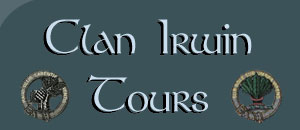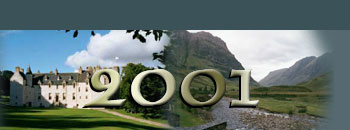 |
 |
Annan
September 27
 |
 |
 |
 |
 |
|
This morning we toured Caerlaverock Castle (pronounced Car-lav-er-ock)
overlooking the Solway Firth. The estate at Caerlaverock was
granted to Sir John De Maccuswell about 1220 with a castle
being built, which was abandoned shortly thereafter and a
new one built on the present site. The Castle was the principal
seat of the Maxwell family and stayed with them for 400 years.
Built of beautiful red sandstone, the castle is in the shape
of a shield, with three sides round it, a tower at each corner
and a double tower at the gate which was protected by a drawbridge
over the inner moat. It figured in many of the Anglo-Scottish
battles as well as those fought between the Scots. The castle
was partially dismantled by the Covenanters after the 1640
siege. Today it exists as a romantic ruin under the care of
Historic Scotland.
We then drove to Annan where we began our tour of Irving
Country and the Irving Towers on the Kirtle Water with our
kinsman, Dr. Bruce Irving of Bonshaw, who is knowledgeable
about genealogy and history of this area. Our day included
viewing the following sites which have been associated with
the Irving family: Hoddam Castle, Robgill, Woodhouse, Stapleton
and Cove. We also saw Repentance tower, the statue of Thomas
Carlyle and his birthplace, the Arched House at Ecclefechan.
We joined Dr. Margaret Irving for drinks at Bonshaw and dinner
at the Dryfesdale Country House Hotel, Dryfebridge, Lockerbie.
We enjoyed seeing Bonshaw again. We greatly appreciated having
Bruce with us for our two-day tour of Irving and Border Reiver
country.
|
 |
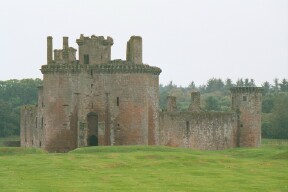
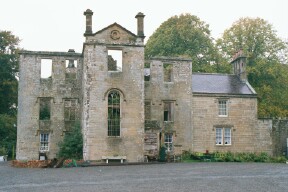
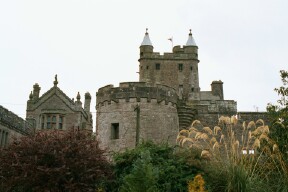
|
|
Bonshaw Tower The
Irvings of Bonshaw were Chiefs of the Border Irvings, a small clan that greatly increased
in size and importance during the 16th century. The present stone tower was built in the
late 1560s by Edward Irving. By this time the Irvings had become close allies of the
Johnstons in their feud with the Maxwells. The tower is located about one-half mile SE
Kirtlebridge. The site is naturally strong standing 70 ft. above the Kirtle Water on the
east side and with a deep ravine on the south side. The other two sides probably had the
usual outer defenses of ditch, rampart and palisade, which were finally destroyed when
the present mansion was built and the gardens laid out in1770.
|
 |
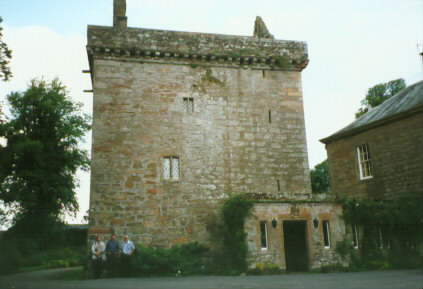 |
|
Robgill Tower In 1536 the Corries sold the lands of Robgill and Stapleton to William
Johnston of Gretna. In 1547 Cuthbert Urwen of Robbgill is mentioned in records. The Irvings built the
present tower with a design similar to that of Bonshaw but, presumably, at a later date. It stands on a
cliff on the right bank of the Kirtle Water, about one mile SE Kirtlebridge.
|
 |
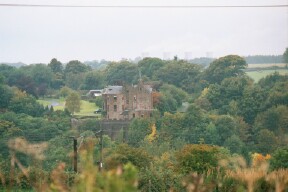 |
|
Stapleton Tower In November 1536, William Johnston alienated ‘the lands of Stabiltoun’
to Christopher Irving of Bonshaw. Stapleton tower is said to have been built by Edward Irvine probably
around the time of the Irvings’ local war with the Maxwells in 1585-86, or even later. The tower is
located about 2 and ¾ miles ENE Annan, located on gently rising ground overlooking the Solway. Apparently
any traces of fortifications were destroyed when a mansion was built; this mansion was demolished after
World War II.
|
 |
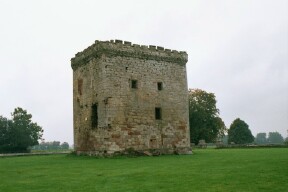 |
|
Woodhouse Tower In 1574 John Johnston sold the lands called ‘Wodhous Johnnestoun’
to Edward Irving of Bonshaw. The tower dates from the latter part of the 16th century, most likely
after the Irvings purchased the property. Woodhouse Tower stands above the Kirtle Water, almost opposite
to Robgill and in full view of Bonshaw and Wyseby, only ¾ mile upstream.
For additional information on the Irving towers see The Border Towers of Scotland: the West March by
Alastair M. T. Maxwell-Irving (2000).
|
 |
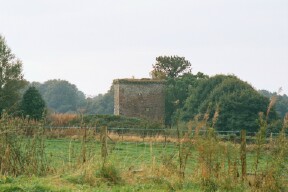 |
|
